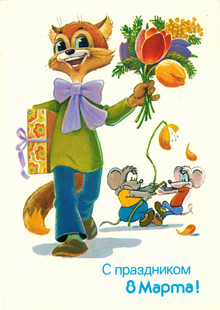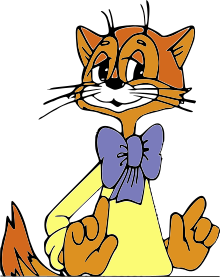| This article needs additional citations for verification. Please help improve this article by adding citations to reliable sources. Unsourced material may be challenged and removed. Find sources: "Leopold the Cat" – news · newspapers · books · scholar · JSTOR (May 2019) (Learn how and when to remove this message) |
| Leopold the Cat | |
|---|---|
| Genre | Fairy tale, Comedy |
| Written by | Arkady Khait |
| Directed by | Anatoly Reznikov |
| Starring |
|
| Composer | Boris Saveliev |
| Country of origin | Soviet Union |
| No. of episodes | 11 |
| Production | |
| Running time | 4–15 minutes |
| Production company | Ekran |
| Original release | |
| Network |
|
| Release | 1975 (1975) – 1987 (1987) |

Leopold the Cat (Russian: Кот Леопольд, Kot Leopold) is a Soviet animated short film series about a good-natured and prudent cat, Leopold. Leopold always wears a bow tie even when swimming. Throughout the series, he has to deal with two mischievous mice, Grey and White (Mitya and Motya according to an early script version, but the cartoons themselves mention no names). The animation was produced at T/O Ekran in 1975–1987 and its runtime is 87 minutes (10 episodes). As of 1987, there were 11 episodes in total. In 1995, most of the episodes were released on DVD.
It was directed by Anatoly Reznikov (Russian: Анатолий Резников), and the screenplay was written by Arkady Khait. Boris Savelyev wrote the music. The operators were by Ernst Gaman (1975, 1981), Igor Shkamarda (1982), and Vladimir Milovanov (1981, 1983, 1984, 1986). Nelli Kudrina was the sound engineer. The character's unusual name came from the antagonist of the movie The New Adventures of the Elusive Avengers named Colonel Leopold Sergeyevich Kudasov.
Leopold's catchphrase is "Guys, let's all get along" (Russian: Ребята, давайте жить дружно). The catchphrases of the two mice are "Come out, Leopold!" (Russian: Выходи, Леопольд!) by the one and "Come out, you foul coward!" (Russian: Выходи, подлый трус!) by the second. The first two episodes, "Revenge of Leopold the Cat" and "Leopold and the Goldfish", were created practically in 1981–1975 parallel, and with a help shifting technique: heroes and decorations were created on cut-out pieces of paper that were shifted under glass. The first two episodes premiered in 1981 and 1985 respectively. Further episodes were realized with the help of hand-drawn animation.
In the first episode, "Revenge of Leopold the Cat", all the roles were voiced by actor Andrey Mironov. He wanted to invite him for a second series ("Leopold and the Golden Fish"), but Mironov fell ill. As a result, all 4 characters were voiced by Gennady Khazanov. From the third ("Treasure of Cat Leopold") to the eleventh ("Car of Cat Leopold") episodes, all the roles were voiced by Alexander Kalyagin. (Excluding the 8th episode of "Interview with Cat Leopold", where Mironov's voice was heard again).
The series is very similar to Tom and Jerry, except unlike Tom and Jerry where the cat is usually the aggressor in here the two mice are the aggressors.
Characters
The main characters are Leopold the cat and the mice. Other characters also appear in some episodes. All characters are anthropomorphic animals that walk on their hind legs, wear clothes, and behave like humans.
Leopold the Cat

A lonely, middle-aged ginger cat lives in house No. 8/16 on Murlykina Street, next to a cafe and a studio. He is depicted as a typical intellectual : he does not smoke, does not drink, and does not raise his voice. Almost always, not excluding street situations, he is dressed in soft blue home trousers rolled up to the knee, a yellow turtleneck, house slippers, and his invariable bow tie, which he does not take off even when bathing.
Leopold is distinguished by his optimism, he is a real peacemaker cat, and his life credo is expressed by the phrase repeated at the end of each episode - "Guys, let's live in peace!" Starting from the third episode, he does not take offense at the mice and does not suffer from their dirty tricks - he only shakes his head disapprovingly; from this episode on, he no longer takes revenge on the mice - they turn out to be victims of their own traps.
Mice
Two mischievous mice. They appear in all episodes except Interview with Leopold the Cat. According to some sources, they were originally named Mitya and Motya, but, according to Arkady Khait, they are deliberately not pronounced in the cartoon - the authors did not want children with names that in a diminutive version could sound like Mitya and Motya, "to be teased as mice, toothy or rodents", so they are usually called according to their appearance - "Grey" and "White".
The Mice duo represent cunning and meanness, they are disgusted by the intelligent and kind Leopold. They usually call Leopold a "vile coward" and look for a way to spite him, but at the same time they themselves become victims of their own tricks and at the end of each episode they repent of their machinations.
In the first two episodes, their appearance does not express their qualities, they are both skinny and have squeaky voices, and the leadership among them changes: in the first episode, White clearly rules, in the second, Gray. Starting from the third episode, the obvious leader and brain center - the inventor of traps and nastiness for Leopold is the skinny and squeaky White, and the heavyset Gray with a bass voice becomes an obedient accomplice and executor of his plans. Sometimes Gray loses patience and gets out of control, for example, in the episode "Leopold the Cat's Clinic" White, trying to give Leopold a sleeping pill injection near the elevator, misses and, by inertia, sticks the syringe into Gray's body, after which he begins to chase him.
Voice cast
- Andrei Mironov voiced the white mouse / the grey mouse / Cat Leopold / Doctor in episodes 1 and 8
- Gennady Khazanov voiced characters: Cat Leopold / Golden Fish / Grey mouse / White mouse in episode 2
- Alexander Kalyagin voiced all characters in episodes 3–7 and 9-11
Episodes
- 1975 — Leopold Cat's Revenge / Месть кота Леопольда
- 1975 — Leopold and the Golden Fish / Леопольд и золотая рыбка
- 1981 — Cat Leopold's Treasure / Клад кота Леопольда
- 1981 — Leopold's TV / Телевизор кота Леопольда
- 1982 — Leopold Goes for a Walk / Прогулка кота Леопольда
- 1982 — Birthday of Leopold the Cat / День рождения кота Леопольда
- 1983 — Leopold's Summer / Лето кота Леопольда
- 1984 — Interview with Leopold the Cat / Интервью с котом Лепольдом
- 1984 — Leopold the Cat in a Dream and in Reality / Кот Леопольд во сне и наяву
- 1986 — Leopold the Cat's Polyclinic / Поликлиника кота Леопольда
- 1987 — Leopold's Automobile / Автомобиль кота Леопольда
See also
- Leopold Mozart, the most common cultural reference in history for Russians
- Nu Pogodi
- Oggy and the Cockroaches, a French cartoon about Oggy, an anthropomorphic cat, that is continually pestered by three roaches named Joey, Marky and Dee Dee.
References
- "Кот Леопольд / Пацифист, богач, одиночка" [Leopold The Cat / Pacifist, Wealthy, Loner] (in Russian). Stary Vidik. 19 April 2020. Retrieved 14 April 2022 – via YouTube.
External links
- Leopold the Cat at IMDb
- Leopold the Cat at Animator.ru
- Leopold the Cat at Animatsiya.net (subtitled in English)
| Animation industry in Russia | |
|---|---|
| Active Animation Studios/Companies | |
| Defunct Animation Studios/Companies | |
| Popular characters | |
| Related topics | |
- Film series introduced in 1975
- 1975 animated short films
- 1975 films
- 1981 animated short films
- 1981 films
- 1982 animated short films
- 1982 films
- 1983 animated short films
- 1983 films
- 1984 animated short films
- 1984 films
- 1986 animated short films
- 1986 films
- 1987 animated short films
- 1987 films
- Soviet animated short films
- Studio Ekran films
- Short film series
- Russian animated short films
- 1970s Soviet films
- Animated films about cats